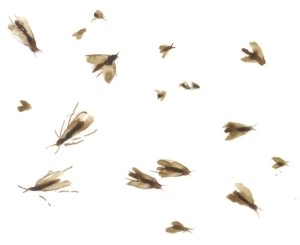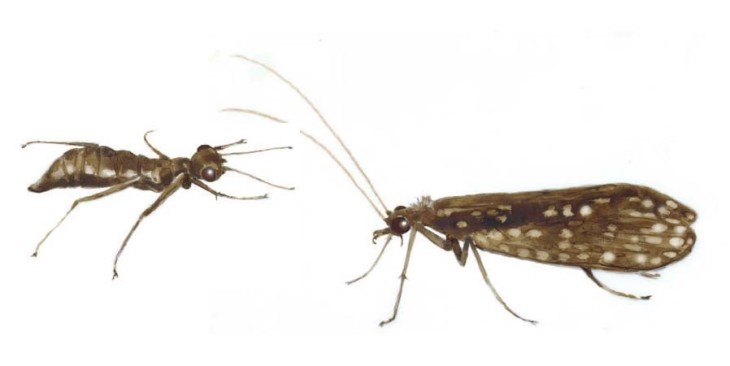
On a late winter afternoon in 1994, I accompanied Professor Jan Sykora, my thesis advisor, on a field trip to the Carnegie Museum’s Powdermill Nature Reserve in Pennsylvania’s Laurel Highlands. Nearing our spring-fed research site, Jan removed his hat and tossed it on the snow. He procured forceps and a vial of alcohol from his pocket, lifted the hat, and picked up from under it a small dark insect, which he dropped in the labeled vial.
“Dolophilodes distinctus,” he exclaimed, “male.” I was impressed! To a new grad student, pulling the Latin name and gender of an insect out of a hat – especially when that insect was small enough to perch comfortably on an aspirin – seemed like a superpower.
Later, as Jan shared his wealth of knowledge, I realized how he had accomplished this hat trick. D. distinctus, the tiny black gold speckled-wing or winter caddisfly, has an unusual life cycle, and it’s one of the few caddisflies that you’re likely to find wandering around in the snow.
This species is a finger-net web spinning caddisfly (family Philopotamidae), meaning that instead of competing with many other aquatic invertebrates for relatively large food items, its larvae spin silk nets to catch very fine particles of organic matter drifting by in the stream water. Of the four caddisfly families that ply nets to gather particles, Philopotamidae spin the finest mesh, with openings measured at approximately 0.5 by 5.5 microns; to put that in perspective, if you are reading this article in a hard copy of the magazine, about 100 of these mesh openings would span the thickness of the page.
The larvae spin their nets on the undersides of stream rocks, anchoring them at the upstream end and using grooves in their silk-gland openings to simultaneously lay down 70 silk strands. Strands along the length are relatively stout, while those that run parallel to the upstream opening are finer. The nets are intricate structures, requiring in total more than half a mile of silk, but they’re hard to see in all of their inflated glory. The moment you lift a rock from a streambed, they collapse in soggy piles. What you’re more likely to see is a slimy patch on the underside of the rock, with a straw-colored larva wriggling its amber head out of one end.
Caddisfly species go through five larval instars. Mature fifth-instar larvae pupate, and a little while later, adults emerge in a synchronized “hatch.” These mass events allow males and females of a species to find each other, and timing varies depending on water temperature. That is why hatches often start downstream – where the water warms sooner – and progress upstream. Most caddisflies have a single hatch in spring, summer, or fall that spreads over a few days to weeks.
The winter caddisfly, however, doesn’t follow this pattern. Instead, it has two hatches, each extending to months, and one of which occurs in winter. This detail about timing was what Jan needed to identify the caddisfly under his hat. There are precious few winter-emerging caddisflies, and the size and color of D. distinctus is particular to that species. Seeing a small black caddisfly was all Jan needed for identification to species. A closer look would have revealed subtle buff to golden flecks on the wings that inspired its common name: “tiny black gold speckled-winged caddis.” But how could he tell the gender of a three-eighths-inch insect without so much as a hand lens? Again, the answer came back to caddisfly natural history.
When D. distinctus emerges in summer, males and females fly about in the usual way, and males follow pheromones, or chemical signals released by the females. But in winter, the females forgo wings entirely and wait, often on snow, for winged males to find them. So the winged caddisfly that Jan lassoed with his cap could only be male.
Another aspect of the caddisfly genus Dolophilodes that is unusual: the pupa actually runs along the water surface to the stream edge. Caddisfly pupae are firmly attached to rocks beneath the water and most use sharp mandibles to liberate themselves from their cocoon before swimming and scrambling ashore and finally shedding their pupal skin. In his book Caddisflies: A Guide to Eastern Species for Anglers and Other Naturalists, Thomas Ames describes particular techniques for mimicking Dolophilodes’ unique sprinting pupa behavior to tempt hungry trout.
If you happen upon a hatch of these fascinating insects, reach for a surface fly such as a Palmer Caddis from your fly box. If you move it just so along the water surface, you may well be rewarded with a handsome brook trout.



